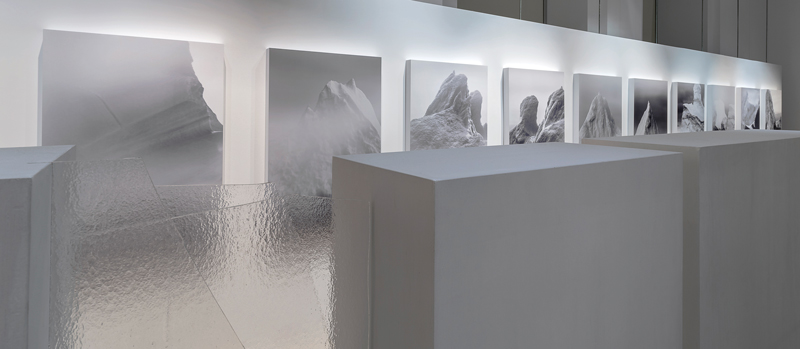[Fall 2017]
Jocelyne Alloucherie, Ivan Binet, and Mathieu Cardin
Vide et vertige
1700 La Poste, Montreal
March 24–June 18, 2017
By James D. Campbell
This exhibition of works by Jocelyne Alloucherie, Ivan Binet, and Mathieu Cardin was brilliantly dovetailed in terms of theme – the constructive notion of “vertigo” and the viewer’s experience in space, with an understanding of void as presence rather than absence – and installed with consummate finesse in mortise-and-tenon fashion from floor to floor in all the gallery spaces. The works demonstrated great visual clarity and successfully interrogated our commonplace assumptions about the bodies we live in and the spaces we inhabit. The experience of vertigo has been philosophically understood in terms of a loss of balance between lived and objective space. Beyond aesthetic canons, the exhibited works communicated directly with viewers’ bodily experience and anxiety sensitivity, as well as their imagination. In this sense, the “vertiginous” experience of the world that all of these works offered was deep, sustained, and complex.
Let us begin on the mezzanine, where Jocelyne Alloucherie catapulted her viewers into a deep-freeze with her photographs and related sculptural elements pertaining to icebergs. Alloucherie is a gifted installation artist as well as a photographer with a long and salutary career. In an earlier exhibition, Dédale, at the Darling Foundry, she nimbly stepped inside the ambit of Montreal’s nightside using photography, installation, and video to conjure up a seductive atmospheric from the city’s network of alleyways. Here, she moves far from the experience of urban vertigo – the inner city – to the domain of icebergs – the interior of nature – with equal assurance.
In her Darling Foundry show, Alloucherie used white-painted architectural elements as framing devices for the alleys shown in the photographs and videos, and as surrogates for architectural forms found in the urban core. Similarly here, she employed white-painted plinths with cut-glass attachments to serve as both scaffolding for the images and portals through which they could be seen. Apparently, she photographed her icebergs up close, from a fishing boat off the coast of Newfoundland, and she captures something of the sheer immensity of their masses relative to her and our own smallness, even as they melt into oblivion, remaining immaterial, menhir-like cold ghosts.
One could either walk alongside the photographic images or view them through the “portholes.” Yet, the somatic and the purely visual experiences – the weight on the body and the fleeting glimpses of holy arctic ghosts on the water – were equally beguiling and resonant. Alloucherie demonstrated in these works that she is at the height of her powers, and the icebergs were at once eloquent and meditative in their intensity, possessing a tactile and altogether alluring lustre.
The “vertigo” experienced before the icebergs, with the viewer perhaps assuming Alloucherie’s position in the tiny boat alongside their flanks, was mirrored in Ivan Binet’s photographs. Binet employed seemingly impossible vantage points, which induced an almost dizzying sense of spatial uncertainty, as one sought to reconcile the “where” of the composition with one’s own station point in space.
Instead of centring the viewer, Binet ensured that we were decentred and, effectively, destabilized as we sought to wrest reconciliation and clarity from our dilemma on the brink. Without recourse to a network of verifiable spatial references, Binet induced the so-called high-place phenomenon with images of a mine tailings pond at Schefferville and of Montmorency Falls at the end of winter, where the angles are sufficiently high to trigger cognitive dissonance – and the urge to jump (down) into the scene.1 The artist draws us into his photographs with the efficacy of certain optical illusions that work mischief on the brain. The mixed signals received in the cerebral cortex demonstrate his enviable success in invoking the forms and forces of nature – the deep chasm and the vertical descent – that affect human beings in certain environments.
Downstairs, illusion and dissimulation also reigned supreme in installation artist Mathieu Cardin’s deconstructed and reconstructed images and sculptures. Cardin places the onus for separating reality from fiction squarely on the optic of the viewer, who is thus complicit in the making of meaning. The topographical segments of landscape have to be reconstituted into the mountain ranges that they in fact are by the viewer, who is thus exposed as the ultimate reference pole. We must decide what is a simulation and what is a real, quantifiable thing, and this heuristic process is somehow the main point of work that insists that its viewers are also actors.
For Cardin, perspective is central to perceiving nature, and the perspective of the viewer is here propelled through hoops, with sculptural tableaux receding in endless iterations through a Hall of Mirrors. Yes, for all his visual hoopla, the artist requires us to bodily attend to the work, walking through and negotiating its spaces with a certain fidelity, thrown into rupture when a caesura opens up between our perception of a thing as real and our sudden discovery that it is only a simulation.
The exhibition was installed on three floors – with Alloucherie on the mezzanine, Binet on the ground floor, and Cardin below stairs – very deliberately and deftly, so as to dovetail complementary bodies of work without collapsing their different philosophies, and in a way that led viewers over the precipice – and beyond.
James D. Campbell is a writer and curator who writes frequently on photography and painting from his base in Montreal.




